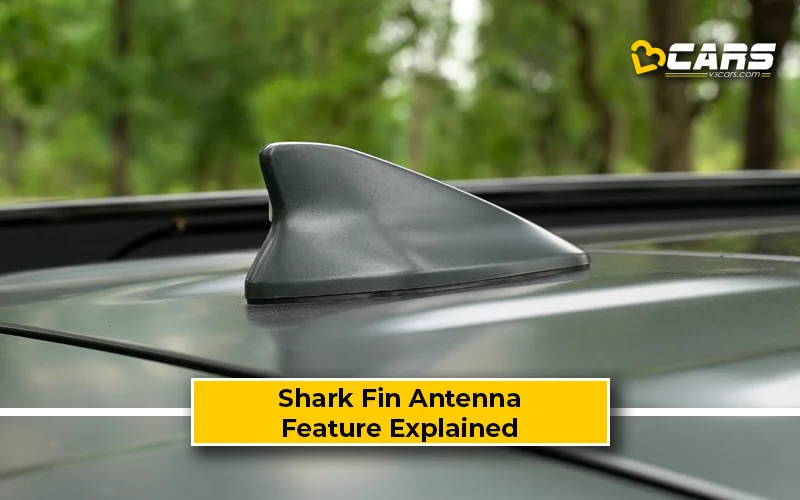Shark Fin Antenna – Feature Explained
The sleek, fin-like protrusion you often see on the roof of modern cars is more than just a stylish design element. It’s a functional antenna, commonly known as a shark fin antenna. Let’s dive into what it is, how it works, its advantages and disadvantages, and aftermarket options in India.

What Is A Shark Fin Antenna?
A shark fin antenna is a type of vehicle antenna designed to resemble the dorsal fin of a shark. It’s typically mounted on the roof of the car, usually towards the rear. Unlike traditional whip antennas that extend upwards, the shark fin antenna has a low-profile, aerodynamic shape.
How Do Shark Fin Antennas Work?
Despite its compact form, a shark fin antenna often houses multiple antenna elements within its streamlined casing. These elements can serve various purposes, including:
- AM/FM Radio Reception: One of the primary functions is to receive traditional AM and FM radio signals.
- GPS Navigation: Many shark fin antennas contain an antenna element specifically for receiving Global Positioning System (GPS) signals, crucial for the car’s navigation system.
- Satellite Radio: In some vehicles, the shark fin antenna also incorporates an antenna for satellite radio reception.
- Mobile Connectivity (e.g., Telematics): Certain advanced shark fin designs may even include antennas for cellular connectivity, supporting telematics services like emergency assistance or connected car features.
The internal circuitry within the shark fin combines the signals received by these different elements and transmits them to the respective systems within the vehicle.
What Are The Pros Of Shark Fin Antennas?
- Improved Aerodynamics: The low-profile, streamlined shape of the shark fin antenna reduces drag compared to traditional whip antennas. This can contribute to slightly better fuel efficiency and reduced wind noise at higher speeds.
- Enhanced Aesthetics: The shark fin design is generally considered more modern, sleek, and integrated with the car's overall styling compared to a long, protruding whip antenna.
- Better Durability: Being a solid, enclosed unit, the shark fin antenna is less susceptible to damage from car washes, low-hanging branches, or vandalism compared to a flexible whip antenna that can be easily bent or broken.
- Multi-Functionality: As mentioned earlier, a single shark fin antenna can often serve multiple purposes (radio, GPS, satellite radio, telematics), consolidating the antenna needs of the vehicle into one unit.
- Reduced Wind Noise: The aerodynamic shape minimises wind resistance, leading to a quieter cabin environment, especially at highway speeds.
What Are The Cons Of Shark Fin Antennas?
- Potentially Weaker AM Reception: In some cases, the smaller size of the antenna element for AM radio within a shark fin might result in slightly weaker reception compared to a longer whip antenna, especially in areas with weak signals. FM and other digital signal reception are usually comparable or better.
- Higher Manufacturing Cost: Shark fin antennas are generally more complex and costly to manufacture than simple whip antennas.
- More Complex to Replace: If a shark fin antenna is damaged, replacing the entire unit can be more involved than simply screwing in a new whip antenna.
- Styling Can Be Polarizing (Subjective): While generally well-received, some individuals might prefer the traditional look of a whip antenna.
Can Shark Fin Antenna Be Fixed From The Aftermarket?
Yes, shark fin antennas can be added or replaced from the aftermarket. Several universal and car-specific shark fin antenna options are available. However, the complexity of the installation depends on the desired functionality:
- Purely Cosmetic: If you only want the look of a shark fin antenna without needing it to be functional, installation is relatively simple. These often stick onto the roof using adhesive.
- Functional Replacement/Upgrade: For a functional aftermarket shark fin antenna to work with your car's radio and other systems, it needs to be properly wired to the existing antenna connections. This might involve removing the old antenna (if present) and connecting the new shark fin antenna's internal wires to the corresponding cables in the car's headliner. This type of installation can be more complex and might require some technical knowledge or professional assistance.
What Is The Cost Of An Aftermarket Shark Fin Antenna?
The cost of an aftermarket shark fin antenna in India can vary significantly based on several factors:
- Brand and Quality: Reputable brands and higher-quality materials will generally cost more.
- Functionality: A purely cosmetic stick-on fin will be the most affordable. Functional antennas with integrated radio and/or GPS capabilities will be more expensive. Antennas supporting satellite radio or telematics will likely be the priciest.
- Vehicle Specificity: Car-specific shark fin antennas designed to perfectly match the contours of a particular model's roof might cost more than universal options.
- Installation Costs: If you choose to have a professional install a functional aftermarket antenna, you'll need to factor in labor charges.
In general, you can expect to find aftermarket shark fin antennas in India ranging from Rs. 300 for basic cosmetic stick-on fins to Rs. 2,000 - Rs. 5,000 or more for functional units with multiple capabilities. Professional installation charges could add another Rs. 500 - Rs. 1,500 depending on the complexity.
What Are Some Affordable Cars In India That Offer A Shark Fin Antenna?
The shark fin antenna has become a fairly common design element, even in more affordable segments in India. Here are some examples of affordable cars currently available in India that offer a shark fin antenna (please note that specific availability might vary depending on the variant):
- Maruti Suzuki Swift
- Hyundai Grand i10 Nios
- Tata Tiago
- Renault Kiger
- Nissan Magnite
- Kia Sonet
- Hyundai Venue
- Tata Nexon
- Maruti Suzuki Brezza
This list is not exhaustive, and the availability of a shark fin antenna can vary depending on the specific model year and variant. However, it demonstrates that this once premium-looking feature has become increasingly accessible in the affordable car market in India.
Note: Check your Car EMI with our - Car Loan EMI Calculator
You can use our Fuel Cost Calculator to see how much any petrol, diesel or CNG car will cost to run based on the latest fuel price in your city.



0 Comments